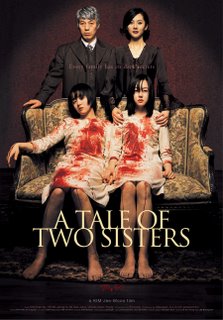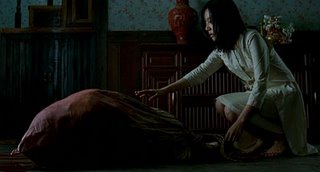A Tale of Two Sisters: DVD Review
 Have you ever had the strange feeling that there really is something in that tiny space between the stove and the floor? And maybe it's, like, watching you?
Have you ever had the strange feeling that there really is something in that tiny space between the stove and the floor? And maybe it's, like, watching you?A Tale of Two Sisters (2003) is Korean director Kim-Jee Woon's brilliant psychological horror film, an attempt to follow in the footsteps of internationally successful Japanese horror films like Ju-On and Ringu. Tale of Two Sisters is like these films in its imagery and atmosphere, but in my opinion it does them one better.
The movie (unsurprisingly) te
 lls the tale of two sisters: they've recently returned from a mental institution to their new, isolated home (a creepy, old house to end all creepy old houses), presided over by their evil step-mother.
lls the tale of two sisters: they've recently returned from a mental institution to their new, isolated home (a creepy, old house to end all creepy old houses), presided over by their evil step-mother.The film's fairytale-like narrative and opulent, creepy atmosphere create a slowly rising sense of dread: strange patterns on the wall, subtle but killing looks between family members, deep dark shadows, all captured in drippingly gorgeous, rich cinematography. By the time the real, jolting scares come--and, boy, do they ever--the director has played his audience like a violin. If you have the surround sound system, plasma screen works, this is a great chance to use it: on the film's rich and detailed masterful visual and sound design.
A Tale of Two Sisters reminded me a lot of David Lynch's Mulholland Drive: it doesn't have a traditional narrative cohesiveness, but rather it's comprised of narrative fragments, a jumbled jigsaw in which the pieces don't necessarily fit together, but the viewer is left to make his own story
 from a slow accumulation of images and events. The first half of the film is straightforward enough, but as in Mulholland Drive, the film contains a sort of "split" in the middle after which the tale starts to become more fragmented.
from a slow accumulation of images and events. The first half of the film is straightforward enough, but as in Mulholland Drive, the film contains a sort of "split" in the middle after which the tale starts to become more fragmented.As in The Others or The Sixth Sense, you're not always sure who's a ghost or who is haunting who, who is dead, what's real or what's a dream. Unlike those films, Tale of Two Sisters does not leave you with any tidy answers. It leaves you floating in the strange atmosphere of the film, its lingering and haunting images and disorienting relationships. In addition to being a horror film, the film is also an intense psychological portrait of family relationships, the guilt, anger and potential violence that often lie beneath the surface, a warning on the dangers of too much hatred and jealousy, but also of excessive devotion.
It's best not to look for one specific narrative
 explanation for what you see: rather, just let the film's terrifying images and creepy atmosphere take you where they want to. As in Mulholland Drive, you may be at a loss to explain what you've just seen, but you know it's taken hold of you. A Tale of Two Sisters is a stylish psychological horror film that keeps its biggest secrets hidden, but still somehow knows just how to get under your skin.
explanation for what you see: rather, just let the film's terrifying images and creepy atmosphere take you where they want to. As in Mulholland Drive, you may be at a loss to explain what you've just seen, but you know it's taken hold of you. A Tale of Two Sisters is a stylish psychological horror film that keeps its biggest secrets hidden, but still somehow knows just how to get under your skin.FilmStocker Rating: B+

0 Comments:
Post a Comment
<< Home